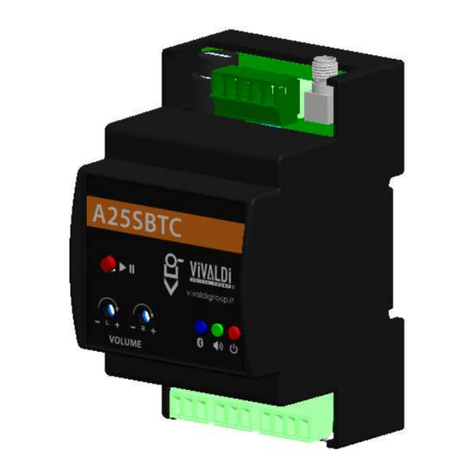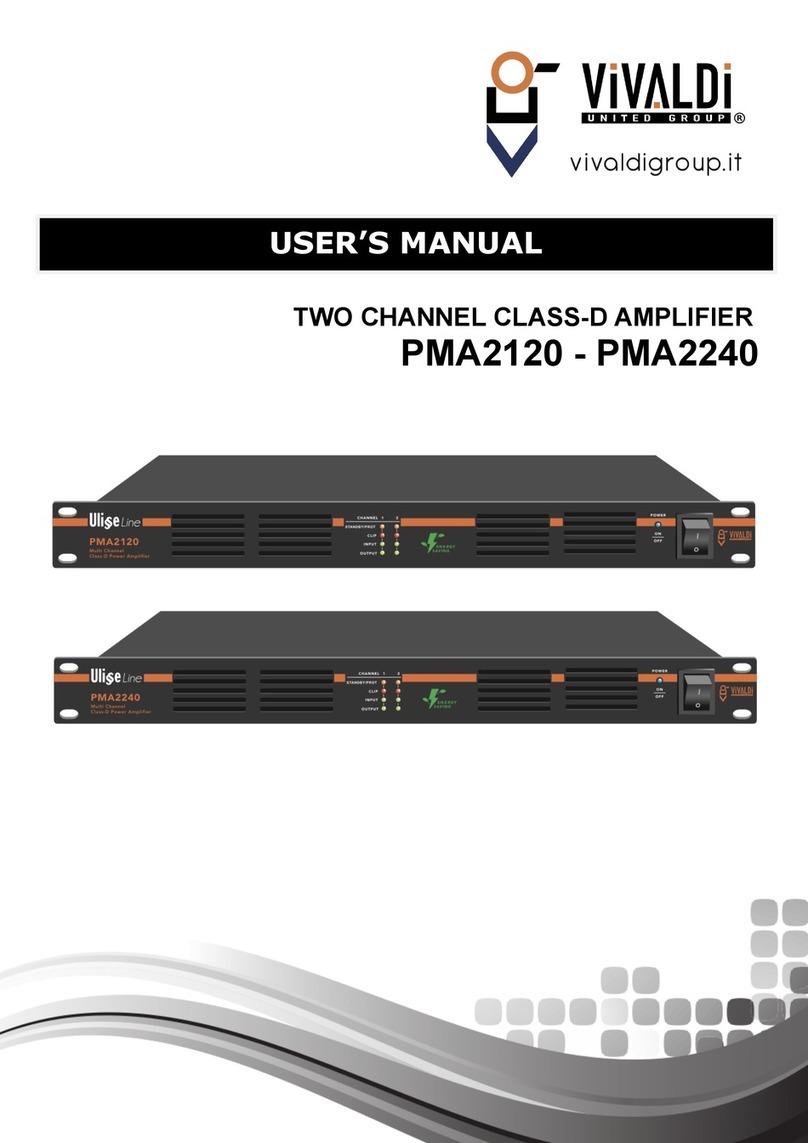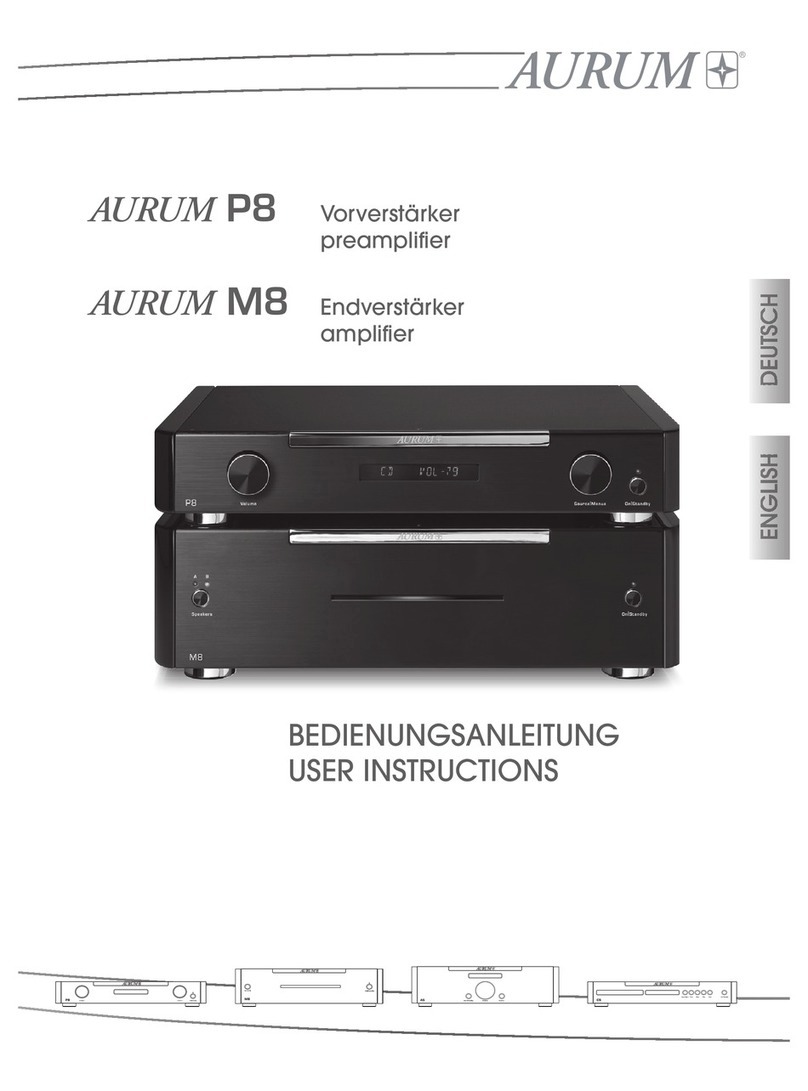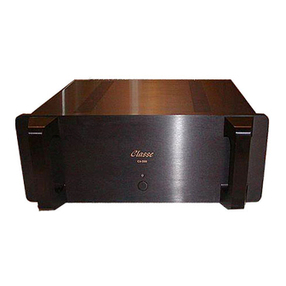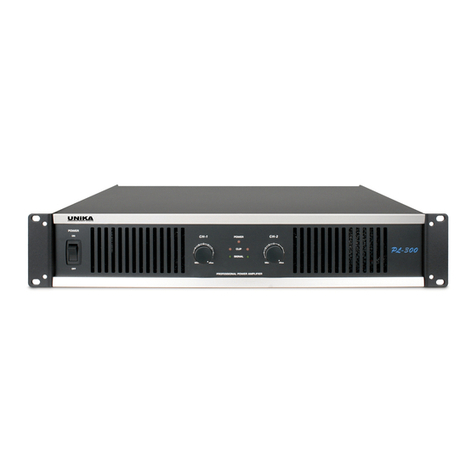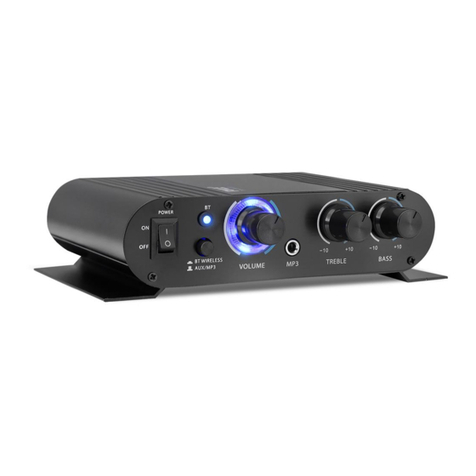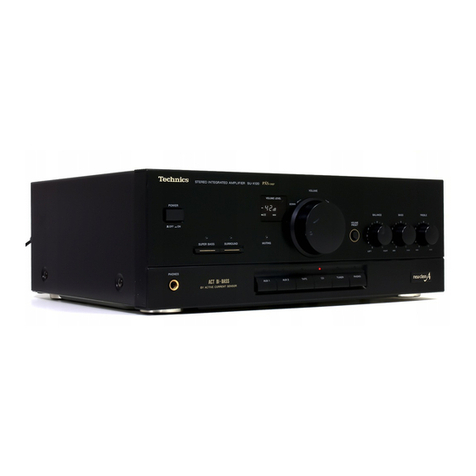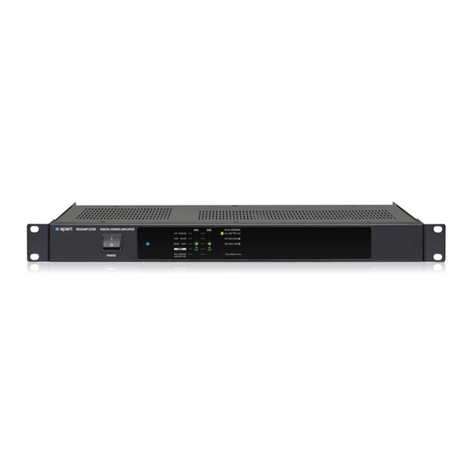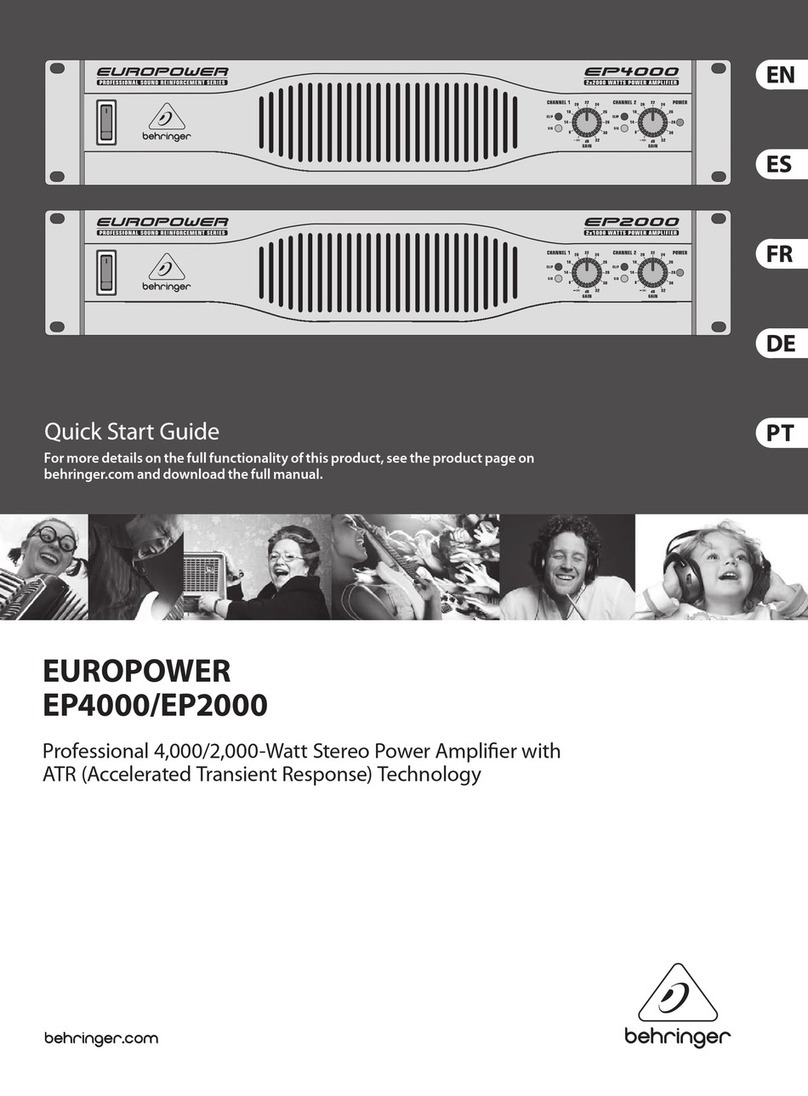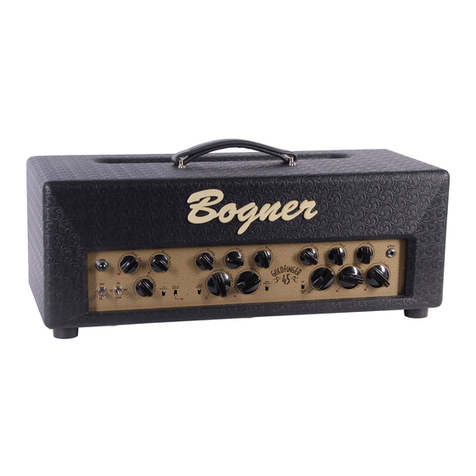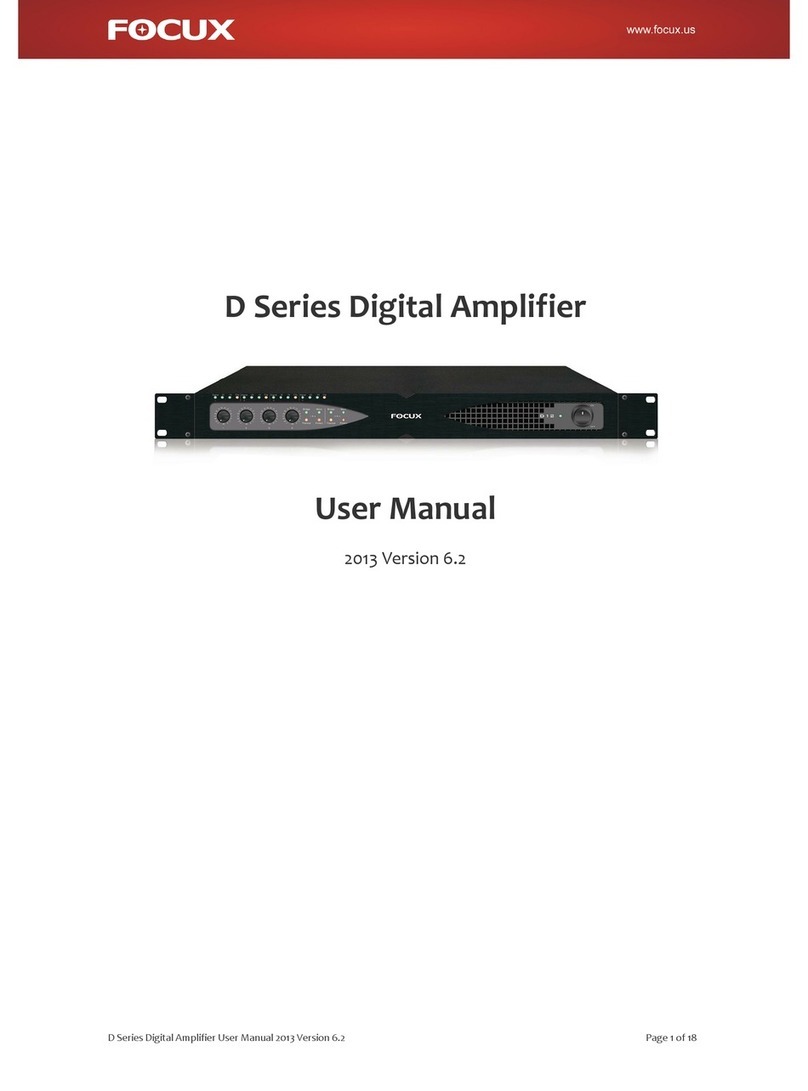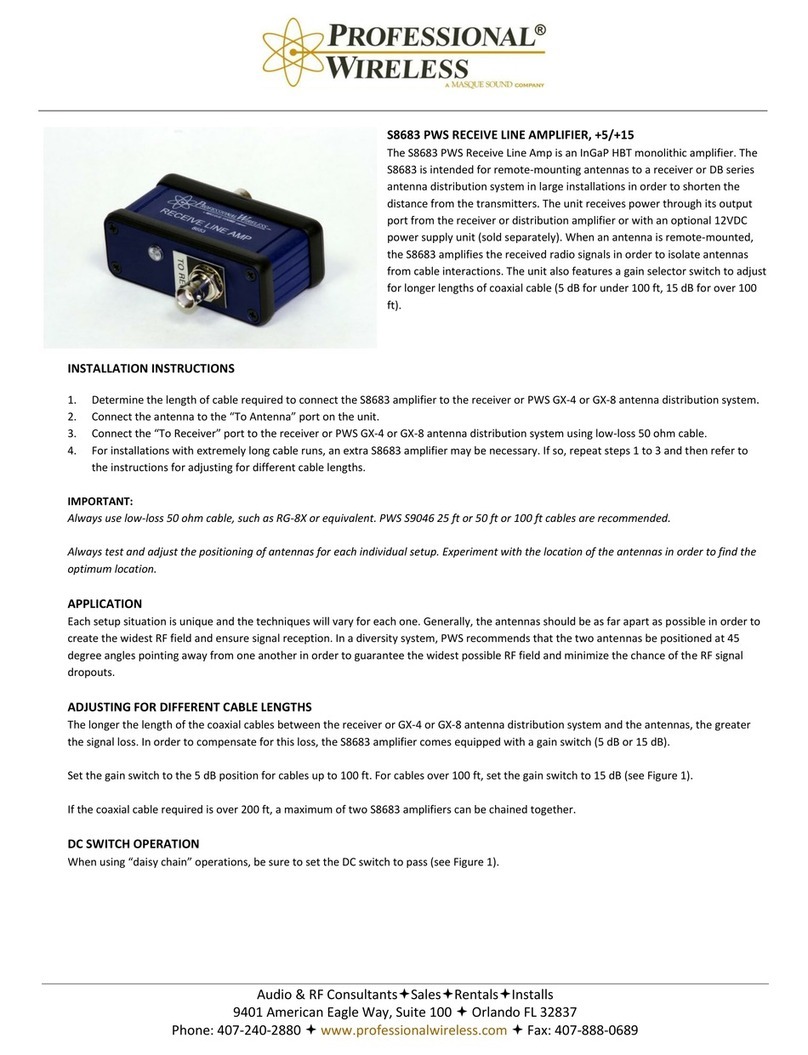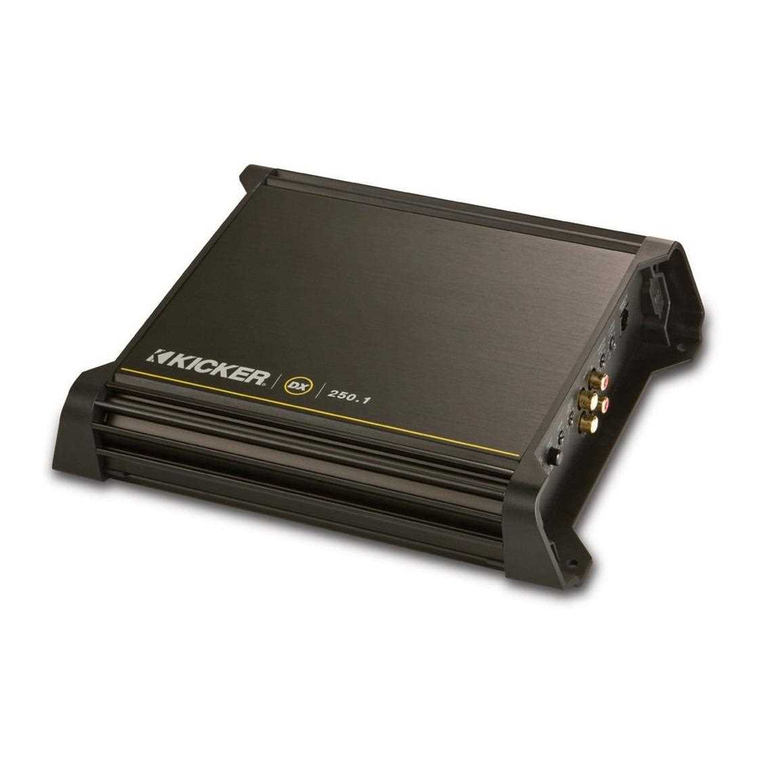Vivaldi MZ4120S User manual

4 ZONE AMPLIFIER MIXER
OPERATION MANUAL
Please follow the instructions in this manual to get the best results from this product.
We also suggest that you keep this manual handy for future reference.
MZ4120S


- 3 -
INDEX
1. SAFETY WARNINGS 4
2. FEATURES 7
3. NAMES AND FUNCTIONS 8
3.1 FRONT PANEL 8
3.2 BACK PANEL 9
4. OPERATION 10
4.1 FIRST TIME STARTUP 10
4.2 “CH1” : “CH5” OPERATING INSTRUCTIONS 10
4.3 MONITOR OUTPUT 10
4.4 MICROPHONE BASE INPUT (BM4) 10
4.5 TELEPHONE INPUT OPERATING INSTRUCTIONS 11
4.6 MULTISOURCE DEVICE OPERATING INSTRUCTIONS 11
4.7 RS232 12
4.8 CH1, CH2, CH3 FUNCTION MODES 14
5. PRIORITY FUNCTION 14
6. CONNECTIONS 14
6.1 SPEAKER CONNECTIONS 14
7. TROUBLESHOOTING 15
8. APPLICATIONS 16
9. BLOCK DIAGRAM 17
10. TECHICAL SPECIFICATION 18
11. DIMENSIONAL SCHEME 19

- 4 -
WARNING
WARNING
CAUTIONS
It indicates a potentially hazardous situation, which, if mishandled, could re-
sult in death or serious personal injury.
It indicates a potentially hazardous situation, which, if mishandled, could re-
sult in minor or moderate damage to the person and/or property damage.
The safety symbols and messages described below are used in this manual to prevent personal
injury and property damage, which could be the improper use. Before putting the product into opera-
tion, read this manual and understand the safety symbols and messages, in order to be fully aware
of the potential risks.
• Do not expose the unit to rain or an environment where it could be wet by water and/or other
liquids, since in this way could cause re or electric shock.
• Use this device only with the voltage specied on the unit. Using a higher voltage than specied
may result in re or electric shock.
• Do not cut, bend, damage, or modify the power cord. Also, avoid using the power cord in the vici-
nity of heat sources and never place heavy objects (including the unit itself), on the power cord,
since in this way could cause re or electric shock.
• Be sure to replace the protective cover of the connection terminals once it has been completed.
Because the speaker connections are of high voltage, never touch these terminals to avoid
electric shock.
• Make sure the connection to the ground terminal is correctly made, in order to avoid electric
shock.
• Do not install or mount the device in an unstable position, such as on a wobbly table or on an
inclined surface. Could lead to the fall of the amplier and cause injury and/or property damage.
Safety symbols and conventional messages
When installing the amplier:
1. SAFETY WARNINGS
• Before use, be sure to read carefully the instructions in this section.
• Be sure to observe the instructions contained in this manual, as well as the conventions of sa-
fety, the safety symbols and messages regarded as very important precautions.
• We also suggest that you keep this instruction manual handy for your own future reference.

- 5 -
CAUTIONS
• Should it occur the following abnormal situations while using the amplier, turn off the power im-
mediately, unplug the power cord from the AC outlet and contact your nearest dealer. Do not try
to start up again the amplier because it could lead to re or electric shock.
9Amplier comes smoke or a strange smell.
9Water or any metal object has entered in the amplier.
9The unit falls, or the frame of the appliance breaks down.
9The power cord is damaged, as well as exposure of the core, disconnection etc.
9The amplier is malfunctioning (no Sound.).
• Do not open nor remove the cover of the unit to prevent re or electric shock, because inside of
the device contains high-voltage components. Contact your local dealer of trust for each main-
tenance.
• Do not place cups, bowls, or other containers with liquid or metal objects on the amplier. If they
accidentally lter inside the unit, possibly resulting in re or electric shock.
• Do not insert or drop metallic objects or ammable materials in the ventilation slots of the unit, it
could cause re or electric shock.
• Do not insert or remove any plug from the electrical power supply with wet hands, may cause
electric shock.
• By unplugging the power cord, be sure to grasp the plug. Do not act on the cable. Put the unit
into operation, with the damaged cord can cause re or electric shock.
• While moving the amplier, be sure to remove its power cord from the wall outlet. Moving the unit
with the power cord plugged in could damage the cord itself and cause a re or electric shock.
• Do not block ventilation openings. May result in overheating and re.
• Avoid installing the amplier in humid and dusty areas, expose to direct sunlight, environments
that generate smoke or steam, as well as locations near heat sources. This could cause a re or
electric shock.
While using the amplier:
Installation of the amplier:

- 6 -
• Do not place heavy objects on the device, it could cause the fall or failure, causing bodily injury
and/or property damage. In addition, the object itself can be damaged.
• Make sure that the volume control is set to minimum before turning on the power. The high audio
product loud when power on, can damage your hearing.
• Do not operate the unit for extended duration of the sound distortion. This is a malfunction indi-
cation, which can cause overheating and re.
• Contact your local retailer for periodic cleaning. The accumulation of dust for an extended period
can cause re or damage.
• If dust builds up on the power plug or the AC wall outlet, it could result in a re. They should be
cleaned periodically. Also, make sure the plug is inserted securely into the wall outlet.
• Turn off the power and unplug the power cord from the AC wall outlet for safety reasons, during
cleaning or when you leave the unit unused for 10 days or more, otherwise it may cause re or
electric shock.
Using the amplier:
The power supply must be protected by a magneto-thermal switch with a contact separa-
tion of at least 3 mm.

- 7 -
2. CHARACTERISTICS
1. Four-channel amplier designed for 3 units of 19“ rack.
2. All input sources can be assigned to 4 different zone outputs simultaneously.
3. The ve input channels are designed with separate control of bass, treble and volume.
4. Three microphone inputs / line with phantom power and sensitivity control.
5. Two aux inputs via RCA with sensitivity control.
6. USB/SD Card MP3 Player
7. Integrated FM Tuner.
8. A 4 zone remote microphone input through RJ45 port (BM4).
9. Four Balanced Output.
10.Versatile speaker outputs for each of the 4 channels: 70V, 100V e 4Ω.
11. A serial control port RS232 for communication with external systems.
12.A priority input to have priority over other input.
13.Priority level input high to low:
Before closing the priority contact:
TEL > MIC1 > Remote MIC > MIC2 = MIC3 = LINE4 = LINE5 = MP3
After closing the priority contact:
MIC1 > TEL > Remote MIC > MIC2 = MIC3 = LINE4 = LINE5 = MP3
14.Monitor output with integrated volume control.
15.Extended protection from thermal shock, short circuit, overload and clip indicators.
16.Provided with isolation switch earthing.

- 8 -
1. Mute button and indicator.
Mute on: the indicator is on.
Mute off: the indicator is off.
2. 4 channels matrix amplier select button
3. Monitor output volume level
4. Monitor output volume control.
Clockwise rotation: increase volume.
Counterclockwise rotation: decrease volume.
5. Zone 1-4 Volume level
6. Zone 1-4 Monitor select switch
7. Zone 1-4 Output level control
8. Main Power switch
9. Power On indicator
10.CH1-CH4 High tone control.
Clockwise rotation: increase high frequencies.
Counterclockwise rotation: decrease high frequencies.
11. CH1-CH4 Low tone control.
Clockwise rotation: increase low frequencies.
Counterclockwise rotation: decrease low frequencies.
12.CH1:CH5 input volume control
13.MP3 Player with USB,SD slot card and FM Tuner
3. NAMES AND FUNCTIONS
3.1 FRONT PANEL

- 9 -
3.2 BACK PANEL
1. AC Power input
2. Phone Input assignment area and volume control
3. CH5 Line input signal and control signal gain
4. CH4 Line input signal and control signal gain
5. CH3 Mic input or Line input signal and control signal gain
6. CH2 Mic input or Line input signal and control signal gain
7. CH1 Mic input or Line input signal and control signal gain
8. Remote Microphone base input (BM4)
9. RS232 port
10.CH1:CH3 signal input selector LINE, PHANTOM, MIC
11. Ventilation slots
12.1-4 speaker output terminals; COM is the common terminal, it must be connected to the negati-
ve terminal of the speaker. The 4Ω terminal can be connected to speakers with constant impe-
dance (4Ω minimum); the terminal 70V can be connected to speakers with constant voltage of
70V; the terminal 100V can be connected to speakers with constant voltage of 100V
13.ZONE 1-4 LINE output signal
14.FM radio antenna
15.Telephone input terminal
16.PRIORITY terminal , change the priority between phone and MIC 1
17.Monitor output terminal
18.Ground isolation switch.

- 10 -
4. OPERATIONS
4.1 FIRST TIME STARTUP
4.2 “CH1” : “CH5” OPERATING INSTRUCTIONS
4.1.1 All volume knobs “LEVEL” are set to “0”.
4.1.2 GAIN Trimmer “CH1 a CH5”, on the back panel, must be set counterclockwise to the mini-
mum.
4.1.3 Dip switch “TEL” all in OFF position. Trimmer “VOLUME” must be set counterclockwise to
the minimum.
4.1.4 Switch the power button to the “ON” position, the indicator light will turn on. Blue means that
the amplier is working properly. Red means that the amplier is going into protection. (Ple-
ase check the connection of the outputs and if the main power reaches the default values.)
4.2.1 The operating procedure is the same for all inputs “CH1” to “CH5”. Take the illustration
“CH2” as an example:
1. Adjust the trimmer “BASS”: to change the gain of the low frequency.
2. Adjust the trimmer “TREBLE”: to change the gain of high frequencies.
3. Adjust the “LEVEL”: To change the volume of the connected source.
4. Button “MUTE”: press to mute the corresponding source.
5. Buttons “Z1” - “Z4”: Each button allows you to assign the input to the corre-
sponding output, each input can be assigned to all four outputs.
6. Adjust the “LEVEL”, to change the volume of the general area.
7. Button “MON”: press button “MON”, to perform a pre-listening of the area
through the use of a monitor speaker (rear terminals).
8. It indicates the signal level. The ignition of the CLIP LED indicates an output
level too high with the possibility of distortion. The LED lights PROT may
indicate a problem with the line speakers or amplier area.
4.2.9 “ZONE 1 ZONE-4” are the four independent zone outputs.
4.3 MONITOR OUTPUT
4.4 MICROPHONE BASE INPUT (BM4)
1. Knob “LEVEL”: Volume control monitor spy.
2. LED bar: display output level.
3. You can monitor only one area at a time.

- 11 -
4.5 TELEPHONE INPUT OPERATING INSTRUCTIONS
4.6 MULTISOURCE DEVICE OPERATING INSTRUCTIONS
Input “TEL.PAGING” input for connection of a telephone exchange.
1. “VOLUME” Adjusting telephone input signal.
2. “ZONE” Dip switch selection area: When set to ON enable audio in the area.
If the device is on, the MP3 mode is started automatically when a USB memory or an SD card is
plugged in.
1. “POWER” button: Press the “POWER” button to turn it on, press again to turn off.
2. “MODE” button: press the “MODE” button to switch between functions, FM tuner, USB and SD.
3. Button “PHP / SCAN” button dedicated to the function Play / Pause the MP3 player and selection
of pre-set FM frequency. If held down, in tuner mode, auto scan will start automatically remem-
bering frequencies found.
4. “NEXT” button: press “NEXT” to advance to the track or to the next frequency.
5. Button “PREV”: press “PREV” to return to the track or the previous frequency.
6. “EQ” button: press the “EQ” to change the equalization curve (MP3 only).
7. Button “VOL +”: press the “VOL+” to increase the volume.
8. Button “VOL”: press the “VOL- to decrease the volume.
NOTE
To take advantage of the storage of the last FM frequency listened,
you must turn off the player via the POWER button before diin switch
(No. 8 on the front panel, page 8).
LAST MEMORY OF FM FREQUENCY:

- 12 -
4.7 Serial Port RS232
Connect the equipment through the serial port to a computer where you installed a communica-
tions software, such as “serial debugging assistant V2.1.Exe”, set the baud rate to 9600, 8 bits, no
parity, 1 stop bit stop (9600 8N1).
Insert commands in the command code, then click the “send” button, you can create commands
and status of action according to the following specications:
1. Command to get the status of the last modied button
Command: FF 05 00 05
2. Command to get the status of the last modied LED
Command: FF 05 01 06
3. Command to get the status of the priority
Command: FF 05 02 07
4. Command to get the status of the telephone input
Command: FF 05 04 09
5. Command to associate the MP3 channel to ZONE 1
Command On: FF 06 81 87 Command Off: FF 06 01 07
6. Command to associate the MP3 channel to ZONE 2
Command On: FF 06 82 88 Command Off: FF 06 02 08
7. Command to associate the MP3 channel to ZONE 3
Command On: FF 06 83 89 Command Off: FF 06 03 09
8. Command to associate the MP3 channel to ZONE 4
Command On: FF 06 84 8A Command Off: FF 06 04 0A
9. Command to associate the CH1 channel to ZONE 1
Command On: FF 06 85 8B Command Off: FF 06 05 0B
10. Command to associate the CH1 channel to ZONE 2
Command On: FF 06 86 8C Command Off: FF 06 06 0C
11. Command to associate the CH1 channel to ZONE 3
Command On: FF 06 87 8D Command Off: FF 06 07 0D
12. Command to associate the CH1 channel to ZONE 4
Command On: FF 06 88 8E Command Off: FF 06 08 0E
13. Command to associate the CH3 channel to ZONE 1
Command On: FF 06 89 8F Command Off: FF 06 09 0F
14. Command to associate the CH3 channel to ZONE 2
Command On: FF 06 8A 90 Command Off: FF 06 0A 10
15. Command to associate the CH3 channel to ZONE 3
Command On: FF 06 8B 91 Command Off: FF 06 0B 11
16. Command to associate the CH3 channel to ZONE 4
Command On: FF 06 8C 92 Command Off: FF 06 0C 12
17. Command to associate the MON channel to ZONE 1
Command On: FF 06 8D 93 Command Off: FF 06 0D 13

- 13 -
18. Command to associate the MON channel to ZONE 2
Command On: FF 06 8E 94 Command Off: FF 06 0E 14
19. Command to associate the MON channel to ZONE 3
Command On: FF 06 8F 95 Command Off: FF 06 0F 15
20. Command to associate the MON channel to ZONE 4
Command On: FF 06 90 96 Command Off: FF 06 10 16
21. Command to associate the CH2 channel to ZONE 1
Command On: FF 06 91 97 Command Off: FF 06 11 17
22. Command to associate the CH2 channel to ZONE 2
Command On: FF 06 92 98 Command Off: FF 06 12 18
23. Command to associate the CH2 channel to ZONE 3
Command On: FF 06 93 99 Command Off: FF 06 13 19
24. Command to associate the CH2 channel to ZONE 4
Command On: FF 06 94 9A Command Off: FF 06 14 1A
25. Command to associate the CH4 channel to ZONE 1
Command On: FF 06 95 9B Command Off: FF 06 15 1B
26. Command to associate the CH4 channel to ZONE 2
Command On: FF 06 96 9C Command Off: FF 06 16 1C
27. Command to associate the CH4 channel to ZONE 3
Command On: FF 06 97 9D Command Off: FF 06 17 1D
28. Command to associate the CH4 channel to ZONE 4
Command On: FF 06 98 9E Command Off: FF 06 18 1E
29. Command to associate the CH5 channel to ZONE1
Command On: FF 06 99 9F Command Off: FF 06 19 1F
30. Command to associate the CH5 channel to ZONE 2
Command On: FF 06 9A A0 Command Off: FF 06 1A 20
31. Command to associate the CH5 channel to ZONE 3
Command On: FF 06 9B A1 Command Off: FF 06 1B 21
32. Command to associate the CH5 channel to ZONE 4
Command On: FF 06 9C A2 Command Off: FF 06 1C 22
33. Command to control MUTE of the channel MP3
Command On: FF 06 9D A3 Command Off: FF 06 1D 23
34. Command to control MUTE of the channel CH2
Command On: FF 06 9E A4 Command Off: FF 06 1E 24
35. Command to control MUTE of the channel CH3
Command On: FF 06 9F A5 Command Off: FF 06 1F 25
36. Command to control MUTE of the channel CH4
Command On: FF 06 A0 A6 Command Off: FF 06 20 26
37. Command to control MUTE of the channel CH5
Command On: FF 06 A1 A7 Command Off: FF 06 21 27
38. Command to control MUTE of the channel CH1
Command On: FF 06 A2 A8 Command Off: FF 06 22 28

- 14 -
4.8 CH1, CH2, CH3 FUNCTION MODES
6.1 SPEAKER CONNECTIONS
5. PRIORITY FUNCTION
6. CONNECTIONS
The inputs has three selectable modes: LINE, PHANTOM, MIC
1) The LINE input is used for audio sources such as CD, VCD, DVD and other audio
devices.
2) The PHANTOM provides input power supply of 48V for condenser microphone.
3) The MIC input is used for ordinary microphones as dynamic microphones.
Dialogue priorities instructions:
The telephone input has the highest priority by default: Telephone > MIC1 > Remote MIC.
The priority can be changed through short circuit the terminal “PRIORITY” on the rear panel. MIC1
has the highest priority> Phone> Remote MIC when “PRIORITY” is in short circuit status.
Total Impedance 40Ω @ 70V - 83Ω @ 100V
NOTE:
*4Ω outputs and 70V / 100V can not be used simultaneously.
*Impedances shown in the gures represent the impedance of the speaker system (load) overall.
WARNINGS Be sure to close the terminal cover, after the connection is com-
pleted, because the terminals are subjected to high voltage. Never
touch these terminals to avoid electric shock.
Total Impedance Total Impedance

- 15 -
7. TROUBLESHOOTING
Situation of malfunction The cause of the problem
There is no sound emission when the con-
nection of line is good
1. The lack of electricity, or the quality of the
connections can be of poor True quality.
2. The fuse has blown
3. The volume is too low
4. There is no signal input
Normal Startup, activation of the protection 1. Short-circuit load or damage
2. The power supply voltage is not stable, too
high or too low
3. Overload
Under normal suddenly it occurs the absence
of noise
1. Overheating, the amplier is in thermal pro-
tection
2. Connect the loose cable

- 16 -
8. APPLICATIONS
FM ANT.

- 17 -
9. BLOCK DIAGRAM

- 18 -
10. TECHNICAL SPECIFICATIONS
MODEL MZ4120S
OUTPUT POWER 4x120W
OUTPUT INTERFACE 4Ω,70V/100V
MONITOR OUTPUT 1W/8Ω
INPUT IMPEDANCE AND SENSIBILI-
TY
CH1,CH2,CH3: MIC: ±2.5mV/600Ω
PHANTOM: ±2.5mV
LINE: ~175mV/10KΩ Balanced input
CH5~6: 350mV/10KΩ Balanced input
TEL: 350mV/10KΩ
REMOTE MIC: ±387mV/10KΩ
TONE Bassi: ±10dB a 500Hz
Acuti: ±10dB a 5000Hz
SNR ≥65dB
OUTPUT LINE 1-4 LEVEL 1V/600Ω(balanced)
FREQUENCY RESPONSE 80Hz-16KHz
MP3 Supporta formato MP3, capacità massima di 32 GB
SD CARD FILE SYSTES Only FAT16, FAT32
THD ≤1%
CONSUMPTION 750W
OWER SUPPLY ~230VAC 50Hz
DIMENSION 484x440x132mm
NET WEIGHT 11,68Kg
GROSS WEIGHT 13,48Kg

- 19 -
11. DIMENSIONAL SCHEME
Keep all round at a distance of at least 10 cm from objects that may obstruct air ow to prevent an
increase in internal temperature of the unit.
Unit: millimeters
At least 100mm
Side 100 Side 100
Top 100

Vivaldi s.r.l.
Via E. Fermi, 8 - Z.I. Est 30020 Noventa di Piave (VE) - Italia
tel. +39 0421 307825 fax +39 0421 307845
www.vivaldigroup.it - [email protected]
Table of contents
Other Vivaldi Amplifier manuals
